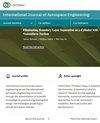从空间实验室的经验教训:图像采集的角度
IF 1.2
4区 工程技术
Q3 ENGINEERING, AEROSPACE
引用次数: 5
摘要
近年来,深度学习(DL)算法的应用提高了基于视觉的空间应用的性能。然而,为训练这些深度学习算法生成大量带注释的数据被证明是具有挑战性的。虽然可以使用合成生成的图像,但在真实环境中测试时,在合成数据上训练的深度学习模型往往容易出现性能下降。在此背景下,卢森堡大学安全、可靠性和信任跨学科中心(SnT)开发了“SnT零重力实验室”,用于在模拟现实世界空间环境的条件下训练和验证基于视觉的空间算法。SnT零重力实验室发展的一个重要方面是设备选择。本文从实验室发展的经验教训出发,提出了一种结合市场调查和实验分析的系统的设备选择方法。本文重点介绍了空间实验室的图像采集设备:背景材料、相机和照明灯。实验分析结果表明,在空间实验室建设项目中,需要在市场调查的基础上辅以实验分析来进行有效的设备选择。本文章由计算机程序翻译,如有差异,请以英文原文为准。
Lessons from a Space Lab: An Image Acquisition Perspective
The use of deep learning (DL) algorithms has improved the performance of vision-based space applications in recent years. However, generating large amounts of annotated data for training these DL algorithms has proven challenging. While synthetically generated images can be used, the DL models trained on synthetic data are often susceptible to performance degradation when tested in real-world environments. In this context, the Interdisciplinary Center of Security, Reliability and Trust (SnT) at the University of Luxembourg has developed the “SnT Zero-G Lab,” for training and validating vision-based space algorithms in conditions emulating real-world space environments. An important aspect of the SnT Zero-G Lab development was the equipment selection. From the lessons learned during the lab development, this article presents a systematic approach combining market survey and experimental analyses for equipment selection. In particular, the article focuses on the image acquisition equipment in a space lab: background materials, cameras, and illumination lamps. The results from the experiment analyses show that the market survey complimented by experimental analyses is required for effective equipment selection in a space lab development project.
求助全文
通过发布文献求助,成功后即可免费获取论文全文。
去求助
来源期刊

International Journal of Aerospace Engineering
ENGINEERING, AEROSPACE-
CiteScore
2.70
自引率
7.10%
发文量
195
审稿时长
22 weeks
期刊介绍:
International Journal of Aerospace Engineering aims to serve the international aerospace engineering community through dissemination of scientific knowledge on practical engineering and design methodologies pertaining to aircraft and space vehicles.
Original unpublished manuscripts are solicited on all areas of aerospace engineering including but not limited to:
-Mechanics of materials and structures-
Aerodynamics and fluid mechanics-
Dynamics and control-
Aeroacoustics-
Aeroelasticity-
Propulsion and combustion-
Avionics and systems-
Flight simulation and mechanics-
Unmanned air vehicles (UAVs).
Review articles on any of the above topics are also welcome.
 求助内容:
求助内容: 应助结果提醒方式:
应助结果提醒方式:


